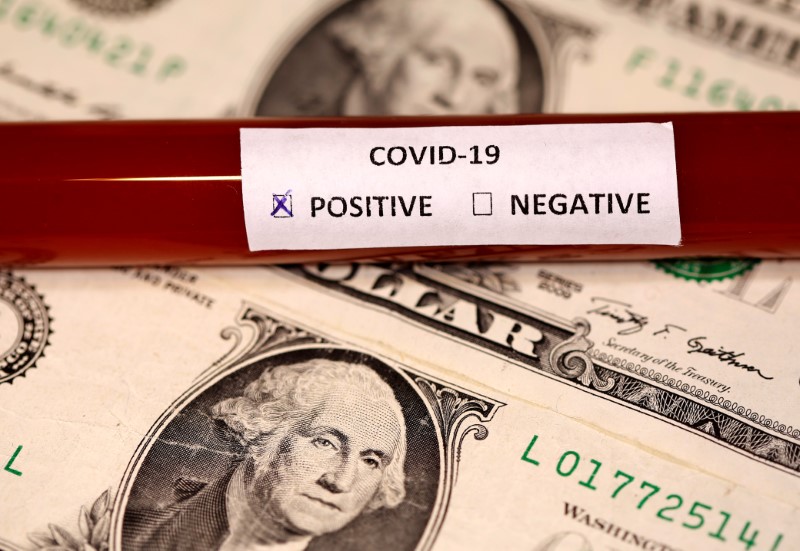By Yoruk Bahceli and Abhinav Ramnarayan
LONDON (Reuters) - Borrowing costs in the United States, euro zone, Britain and Japan surged on Wednesday after two days in which governments across the globe announced trillions of dollars of spending to support locked-down economies frozen by the coronavirus.
Bond markets struggled to assess the scale of borrowing that may be needed to fund spending programs including direct transfers to households, tax breaks for business, income support and loan guarantees, as well as whether central banks may be forced to directly monetize those debts with new money.
The sell-off in Italy's sovereign bond was sharpest, forcing the European Central Bank to intervene to stabilize the market via the Bank of Italy.
Bond sales were exacerbated by dire trading conditions across financial markets, reflecting a lack of two-way trading and liquidity as well as concerns that investment funds were forced sellers of top-rated assets to raise cash to meet expected redemptions after weeks of portfolio losses.
The spread between bids and offers -- a key liquidity gauge -- widened sharply https://tmsnrt.rs/2wg0T1u.
Graphic: Bid-ask spreads widen on major govt. bond markets - https://fingfx.thomsonreuters.com/gfx/editorcharts/EUROZONE-BONDS/0H001R8HBCE7/eikon.png
Government support programs announced so far come to well in excess of $2 trillion for the G7 economies. Several countries have indicated more is to come.
Economists at Germany's Commerzbank (DE:CBKG) estimate U.S. government pledges were equivalent to the packages announced by President Barack Obama 11 years ago and would raise the budget deficit to about 8.5% of output for 2020 and 2021 - compared to 9.8% in 2009. Total debt to output would likely rise to more than 100%, they said.
Rabobank economists estimate government spending announced by the five biggest euro zone economies amounts to between 1.8% to 2.4% of gross domestic product, with liquidity measures ranging between 8% and 16% of GDP.
Germany alone could raise up to 35 billion euros of new debt this year, according to some estimates - around 17% percent more than already budgeted.
"The concern remains that the sizeable fiscal responses we are seeing...only accentuate credit risk on the part of more heavily indebted euro zone members," said Richard McGuire, head of rates strategy at Rabobank.
Italy, with a debt-to-GDP ratio of 135%, plans extra spending of 25 billion euros, or 1% of annual output, while Spain's 200-billion euro package equals a fifth of its gross domestic product. Its debt pile is 98% of GDP.
MARKETS REPRICE
U.S. 10-year borrowing costs jumped back above 1% on Wednesday (US10YT=RR) and are up almost 75 basis points from recent record lows. Germany's 10-year yields at one point looked set to rise above 0% for the first time since April 2019 and are up more than 60 bps from record lows at the start of last week.
Italy was the worst-hit market on Wednesday. Its 10-year yields blew out 60 basis points to 3% before pulling back after the Bank of Italy intervened on behalf of the European Central Bank and after a report that EU leaders are working on a plan that may lead to crisis purchases of Italian bonds by the ECB.
The yield premium investors demand of Italian government debt over its German equivalent has risen 100 bps this week.
Investors expect the European Central Bank to up its bond-buying plan from the 120-billion euro increase it announced last week and that it may take further measures to "close spreads", or reduce the premium over German bond yields.
Some investors believe Germany may consider the idea of pooled euro zone bonds, which it has long opposed. German Chancellor Angela Merkel on Tuesday acknowledged this was being discussed and did not rule anything out.
"In areas like the periphery, you can't allow the tightening of financial conditions. Ultimately, the ECB will be dragged towards yield curve control and more explicit control with respect to bond spreads if it wants the euro to continue," said Mark Dowding, co-head of investment grade at BlueBay Asset Management, which manages $59 billion.
Highlighting the pressure, Spanish and French yield spreads relative to Germany have jumped to three and four year highs. (DE10FR10=RR) (DE10ES10=RR).
Earlier, Japanese yields rose to the highest since Dec 2018 and British government 10-year borrowing costs rose almost 30 bps, the biggest one-day rise since 1998
GOOD THING?
Some investors see the yield rebound as positive.
Andrew Sheets, chief cross-asset strategist at Morgan Stanley (NYSE:MS), said a steeper U.S. yield curve should be welcomed because long-dated borrowing costs rising more than short-dated ones implied better growth prospects ahead.
"The bond market has got this right all along. It sniffed out that the global economy was not in a good place and it was dead right," Sheets said.
"Now it's saying that looking longer-term, maybe this is okay... It's consistent with the thinking that you have fiscal stimulus and you get better growth later."
But liquidity is an immediate problem which may be exacerbating price moves.
Analysts said leveraged investors had been extremely long government bond markets thanks to a recent rush for safety, a trade that had paid off until now.
"The liquidity situation is horrendous," said Salman Ahmed, investment strategist at Lombard Odier.

"Pre-crisis, banks would step in and buffer the shock. Now there are no banks, only mutual funds which are having a run on their funds, it's all impatient money."